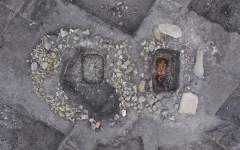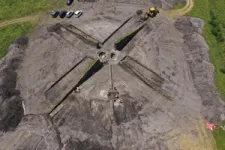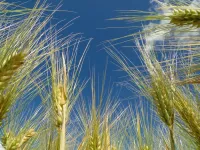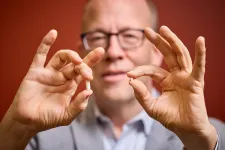(Press-News.org) The researchers discovered evidence of horse riding by studying the remains of human skeletons found in burial mounds called kurgans, which were between 4500-5000 years old. The earthen burial mounds belonged to the Yamnaya culture. The Yamnayans had migrated from the Pontic-Caspian steppes to find greener pastures in today´s countries of Romania and Bulgaria up to Hungary and Serbia.
Yamnayans were mobile cattle and sheep herders, now believed to be on horseback.
“Horseback-riding seems to have evolved not long after the presumed domestication of horses in the western Eurasian steppes during the fourth millennium BCE. It was already rather common in members of the Yamnaya culture between 3000 and 2500 BCE”, says Volker Heyd, Professor of Archaeology at the University of Helsinki and a member of the international team, which made the discovery.
These regions west of the Black Sea constitute a contact zone where mobile groups of herdsmen from the Yamnaya culture first encountered the long-established farmer communities of Late Neolithic and Chalcolithic traditions. For decades, the Early Bronze Age expansion of steppe people into southeastern Europe was explained as a violent invasion.
With the advent of ancient DNA research, the differences between these migrants from the east and members of local societies became even more pronounced.
“Our research is now beginning to provide a more nuanced picture of their interactions. For example, findings of physical violence as were expected are practically non-existent in the skeletal record so far. We also start understanding the complex exchange processes in material culture and burial customs between newcomers and locals in the 200 years after their first contact”, explains Bianca Preda-Bălănică, another team member from the University of Helsinki.
Horse riding is a pivotal moment in human history
The use of animals for transport, in particular the horse, marked a turning point in human history. The considerable gain in mobility and distance had profound effects on land use, trade, and warfare. Current research has mostly focused on the horses themselves. However, horse-riding is an interaction of two components – the mount and its rider – and human remains are available in larger numbers and more complete condition than early horse remains. Since horseback riding is possible without specialized equipment, the absence of archaeological finds with regard to earliest horsemanship does not come unexpected.
Traces of horsemanship can be found in the skeletons
“We studied over 217 skeletons from 39 sites of which about 150 found in the burial mounds belong to the Yamnayans. Diagnosing activity patterns in human skeletons is not unambiguously. There are no singular traits that indicate a certain occupation or behavior. Only in their combination, as a syndrome, symptoms provide reliable insights to understand habitual activities of the past.”, explains Martin Trautmann, Bioanthropologist in Helsinki and the lead author of the study.
The international team decided to use a set of six diagnostic criteria established as indicators of riding activity (the so-called “horsemanship syndrome”):
1. Muscle attachment sites on pelvis and thigh bone (femur);
2. Changes in the normally round shape of the hip sockets;
3. Imprint marks caused by pressure of the acetabular rim on the neck of the femur;
4. The diameter and form of the femur shaft;
5. Vertebral degeneration caused by repeated vertical impact;
6. Traumata that typically can be caused by falls, kicks or bites from horses.
To increase the diagnostic reliability, the team also used a stricter filtering method and developed a scoring system that takes into account the diagnostic value, distinctiveness and reliability of each symptom. Altogether, out of the 156 adult individuals of the total sample at least 24 (15.4%) can be classified as 'possible riders', while five Yamnaya and two later as well as two possibly earlier individuals qualify as 'highly probable riders'. “The rather high prevalence of these traits in the skeleton record, especially with respect to the overall limited completeness, show that these people were horse riding regularly”, Trautmann states.
If the primary use of horseback riding was as a convenience in a mobile pastoral lifestyle, in allowing a more effective herding of cattle, as means of swift and far-ranging raids or just as symbol of status needs further research.
Could it all have happened even earlier?
“We have one intriguing burial in the series” remarks David Anthony, emeritus Professor of Hartwick College USA and also senior co-author in the study.
“A grave dated about 4300 BCE at Csongrad-Kettöshalom in Hungary, long suspected from its pose and artifacts to have been an immigrant from the steppes, surprisingly showed four of the six riding pathologies, possibly indicating riding a millennium earlier than Yamnaya. An isolated case cannot support a firm conclusion, but in Neolithic cemeteries of this era in the steppes, horse remains were occasionally placed in human graves with those of cattle and sheep, and stone maces were carved into the shape of horse heads. Clearly, we need to apply this method to even older collections.”
Short fact box: Who were the Yamnayans?
The Yamnayans were a population and culture that evolved in the Pontic-Caspian steppes at the end of the fourth millennium BCE.
By adopting the key innovation wheel and wagon, they were able to greatly enhance their mobility and exploit a huge energy resource otherwise out of reach, the sea of steppe grass away from the rivers, enabling them to keep large herds of cattle and sheep. Thus committing to a new way-of-life, these pastoralists if not first true nomads in the world expanded dramatically within the next two centuries to cover more than 5000 kilometers between Hungary in west and, in form of the so-called Afanasievo culture, Mongolia and western China in the east. Having buried their dead in grave pits under big mounds, called kurgans, the Yamnayans are said to be the first having spread proto-Indo-European languages.
More information on the research:
https://www.helsinki.fi/en/researchgroups/the-yamnaya-impact-on-prehistoric-europe
END
The world’s first horse riders
2023-03-03
ELSE PRESS RELEASES FROM THIS DATE:
Detecting anaemia earlier in children using a smartphone
2023-03-03
Researchers at UCL and University of Ghana have successfully predicted whether children have anaemia using only a set of smartphone images.
The study, published in PLOS ONE, brought together researchers and clinicians at UCL Engineering, UCLH and Korle Bu Teaching Hospital, Ghana to investigate a new non-invasive diagnostic technique using smartphone photographs of the eye and face.
The advance could make anaemia screening more widely available for children in Ghana (and other low- and middle-income countries) where ...
Israel: the origin of the world's grapevines
2023-03-03
A recent study on the genetic makeup of grapevine has revealed fascinating insights into its domestication and evolution. The study, published in the journal Science, suggests that the harsh climate during the Pleistocene era resulted in the fragmentation of wild ecotypes, which paved the way for the domestication of grapevine about 11,000 years ago in the Near East (Israel) and the Caucasus.
The research team sequenced the genomes of 3525 grapevine accessions (2503 V. vinifera (domesticated) and 1022 V. sylvestris (wild) accessions of grapevine, to identify the genetic changes that occurred during domestication and evolution of grapevine in Euro-Asia.
According to the study, ...
IPK researchers provide insights into grain number determination mechanism of barley
2023-03-03
Modifying inflorescences with higher grain capacity is vital for crop grain production. One recurring target is to select inflorescences with more branches or floral structures. Prominent examples include genes affecting floral identity or meristem determinacy, for which natural or induced variants profoundly change floral primordium number. Yet for temperate cereal crops, such as wheat and barley, excessive floral structures can result in a degeneration penalty due to the indeterminate nature of meristems. On the other hand, the manifestation of this reproductive potential can be accentuated by environmental ...
Pitt and UCI researchers receive grant to understand patient reactions to Alzheimer's disease diagnoses
2023-03-03
University of Pittsburgh and University of California, Irvine (UCI) researchers have received funding from the National Institute of Aging to advance understanding of real-world patient and family member reactions to biomarker-informed Alzheimer’s disease and related disorders diagnoses.
The grant, which is expected to total $3.5 million over up to five years, will enable researchers to better understand the experiences and potential psychological impact of receiving Alzheimer’s biomarker results. These findings will provide important information for supporting patients and their families and inform best practices in the rapidly evolving state-of-the-art diagnostic ...
Oncotarget | Unveiling the non-canonical functions of EZH2 in prostate cancer
2023-03-03
“In summary, both articles by Yi et al. emphasized the significance of non-canonical functions of EZH2 during PCa [prostate cancer] development [...]”
BUFFALO, NY- March 3, 2023 – A new editorial paper was published in Oncotarget's Volume 14 on February 11, 2023, entitled, “Unveiling the non-canonical functions of EZH2 in prostate cancer.”
Prostate cancer (PCa) is ranked as the second leading cause of cancer-related death among American men excluding skin cancer. ...
Adding antipsychotic med to antidepressant may help older adults with treatment-resistant depression
2023-03-03
For older adults with clinical depression that has not responded to standard treatments, adding the drug aripiprazole (brand name Abilify) to an antidepressant they’re already taking is more effective than switching from one antidepressant to another, according to a new multicenter study led by Washington University School of Medicine in St. Louis.
Aripiprazole originally was approved by the FDA in 2002 as a treatment for schizophrenia but also has been used in lower doses as an add-on treatment for clinical depression ...
American Foregut Society white paper recommends expanding endoscopic classification of esophogastric junction integrity beyond hill grade
2023-03-03
A new white paper by the American Foregut Society recommends expanding the classification of the esophagogastric junction (EGJ) to increase an assessment of the axial hiatal hernia length, hiatal hernia aperture diameter, and presence or absence of the flap value making it more comprehensive. The white paper is published in the December issue of Foregut, the only subscription journal focused exclusively on foregut disease linking medical, endoscopic, and surgical disciplines.
Gastrointestinal reflux disease ...
A good night’s sleep may make it easier to stick to exercise and diet goals, study found
2023-03-03
Research Highlights:
People who had higher scores for sleep health — based on regularity, satisfaction, alertness, timing, efficiency and duration — during a 12-month weight loss program were more likely to follow the caloric intake and exercise components of the program in comparison to peers who scored lower for sleep health.
People with better sleep health attended more of the program’s group sessions.
Embargoed until 10:15 a.m. CT/11:15 a.m. ET, Friday, March 3, 2023
DALLAS, March 3, 2023 — ...
Grant fuels project to highlight untold history across Appalachia
2023-03-03
From working with Appalachian communities to examining issues of displacement for refugees, two Virginia Tech faculty have made it their life and scholarly mission to recognize the people that society often overlooks.
Now a prestigious national foundation is giving them significant resources to tell the hidden historical stories of communities throughout Southwest Virginia, an opportunity to put their passion into action.
Emily Satterwhite and Katrina Powell received a $3 million grant from the Andrew W. Mellon Foundation for a three-year project to work with communities across the state’s Appalachia region to commemorate neglected histories.
Their project, Monuments ...
Augmenting the human body with a wearable robotic arm
2023-03-03
Washington, AAAS Annual Meeting. Imagine having a third arm – a robotic one – to assist you with daily living. Silvestro Micera from EPFL, Switzerland, is engineering the human nervous system to make this a possibility.
For decades, professor Silvestro Micera of EPFL has dedicated his research to helping people with sensory and motor deficits to re-gain independence and quality of life by developing wearable and implantable technologies. But this is changing, as he begins to explore what it means to augment the human body.
The neuroengineer has thus far avoided the subject of ...





